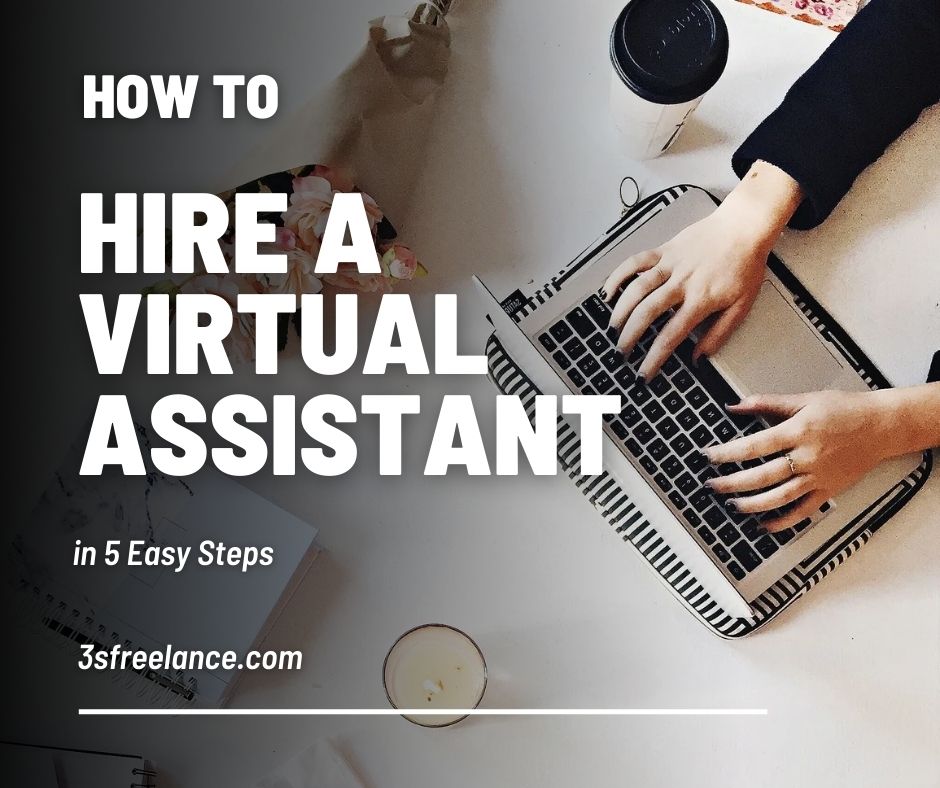In 5 easy steps, I’ll tell you how to hire a virtual assistant in 2024 while increasing your productivity and reducing time waste!
Everyone talks about hiring a virtual assistant to free up time for more strategic work within your business. And it’s true!
The high volume of tasks in any business is enormous, so delegating them allows you to focus on what truly matters.
While the benefits are clear, few people know how to hire a virtual assistant who can deliver quality work with minimal supervision.
I’ve come across countless complaints online about disappointing experiences with virtual assistants.
Having started my freelancing career as a virtual assistant a couple of years ago, and later hiring VAs for various projects, I understand the common pitfalls firsthand.
This is exactly why I’m writing this article — to make your process efficient and less time-consuming.

Step 1: Clarify Your Needs and Define Goals
Know What You Want
I know, this sounds obvious, but trust me, it is not!
Before you start looking for a virtual assistant to hire, get crystal clear on what you need help with. Are you drowning in emails? Struggling with scheduling? Or maybe you need someone to handle your social media?
I’ve seen multiple VA job descriptions where the client is very vague about their needs. I can’t blame them! Some business owners struggle to figure everything out on their own, and that’s totally fine.
Here are some actionable tips to help you get a clear idea of what you really need help with:
- Task Inventory: Write down every task you handle daily, weekly, and monthly. This will help you identify repetitive tasks that can be delegated.
- Prioritize: Rank these tasks based on their importance and time consumption. Focus on delegating lower-priority tasks that eat up your time. This could be a weekly report that takes you 2-3 hours to create, or a daily appointment scheduling task that requires at least 1 hour each day.
- Define Goals: Clearly state what you want to achieve before you hire a virtual assistant. Whether it’s freeing up time, increasing productivity, or scaling certain operations, having defined goals will guide your hiring process.
- Skills Matching: Identify the skills required for the tasks you plan to delegate. This ensures you find a VA who is a good fit for your specific needs.
Real-Life Example: I once thought I needed a VA for email outreach. Turned out, the contact research was my real bottleneck. Once I delegated that, productivity shot through the roof.
Step 2: Identify the Skills Required
Skills Matter
I can even say it’s the most important factor!
You wouldn’t hire a plumber to fix a leaky roof, right? Same logic applies here. Pinpoint the skills your virtual assistant needs to crush it.
- Technical Skills: Whether it’s proficiency in Microsoft Office, Google Suite, or niche-specific software, be as specific as you can.
- Experience Level: Do you need a seasoned pro or can you train a newbie? Clarifying this from the start is crucial.
- Soft Skills: Communication, reliability, and problem-solving are non-negotiable. Add any other soft skills specific to your niche. You’d be surprised how often these skills are overlooked. Just because we excel in certain areas, we assume others do too, which isn’t always the case.
Pro Tip: When I hired my first VA, I overlooked the importance of soft skills. Big mistake. A technically skilled VA who can’t communicate is a headache waiting to happen.
Step 3: Choose the Right Hiring Platform
Where to Look
Not all hiring platforms are created equal. Choose one that suits your needs and budget.
- Freelance Websites: such as: Upwork, Freelancer, FreeUp. Great for finding diverse talent at varying price points.
- VA Agencies: For US based VAs: Belay, Time Etc, MyTasker. They handle the vetting process but come at a premium.
- Job Boards: LinkedIn, Indeed, Remote.co. Ideal for casting a wider net.
Insider Tip: One of my clients found their rockstar VA on Upwork after a disastrous experience with an agency VA who wasn’t the right fit. Sometimes, your own vetting process works better than expected!
Step 4: Screen and Interview Candidates
The Vetting Process
Please, don’t rush this step. Your VA will be a crucial part of your team. It’s important you take your time to select the right talent.
Here are the main tips for conducting a successful vetting process:
- Initial Screening: Skim resumes and cover letters for relevant experience and skills. Look for key achievements and relevant keywords. Many people fill their resumes with jargon they might not fully understand, which is why an interview is essential.
- Conduct Interviews: Video calls are best. Ask about their experience, problem-solving abilities, and how they handle deadlines. A common question we ask VAs is how they prioritize their tasks. Some will describe their proficiency with task management software that sends them mobile notifications for deadlines, while others might reveal they still rely on an old notebook to track everything.
- Test Assignments: A small, paid task can reveal a lot about their work ethic and skills. As a freelancer, I used to accept test projects before taking on new work, especially when my experience was limited. These tests helped save both my time and the client’s time by ensuring we were aligned on what needed to be done.
Remember: When unsure, you can ask candidates to complete a simple task related to the job. It’s a great way to see their skills in action. Because we all know how interviews and resumes can be misleading!
Step 5: Onboard and Integrate Your VA
Onboarding is Key
Congratulations! You’ve found your virtual assistant. Now, integrate them smoothly into your workflow. This step is crucial to future success for multiple reasons.
First, I’ve seen the results of a poor onboarding process time and time again. It’s frustrating for both the client and the virtual assistant. You can’t just bring people into your company without proper onboarding—yet, it happens in multiple organizations.
Sometimes everyone is too busy to explain things to newcomers, but this is never an excuse. A lack of onboarding leads to confusion, mistakes, and wasted time.
To prevent a disaster, here’s what you should do:
- Create a Detailed Onboarding Plan: Outline every step of the onboarding process, from initial introductions to training on specific tasks and tools. Make sure this plan is clear and comprehensive.
- Provide Necessary Resources: Give your new VA access to all the tools, documents, and resources they’ll need. This includes login credentials, user manuals, and any training materials.
- Assign a Line Manager: Pair your new VA with a more experienced team member who can guide them through the initial stages, answer questions, and provide support. They should also report to someone at least on weekly basis.
- Set Clear Expectations: Clearly communicate roles, responsibilities, and performance expectations from day one. Ensure your VA understands what is expected of them and how their performance will be evaluated.
- Regular Check-ins: Schedule regular check-ins to discuss progress, provide feedback, and address any issues or concerns. This helps in keeping the VA on track and makes them feel supported. It only takes a few minutes but the impact is huge!
Quick Tip: I set up weekly check-ins with my VA to ensure everything’s on track and address any issues promptly. It’s truly a game-changer.
Key Takeaways
This was your short step-by-step guide on How to Hire a Virtual Assistant in 2024.
Here are the key points to remember:
- Clarify your needs, identify the required skills
- Choose the right platform to hire a virtual assistant depending on your budget and preferences
- Make sure you have a proper vetting process
- And .. don’t forget to tell them what to do after you hire them!
The key to success lies in clear communication, mutual respect, and continuous feedback.


